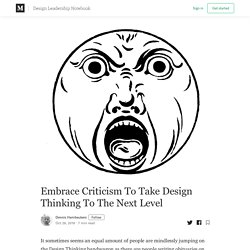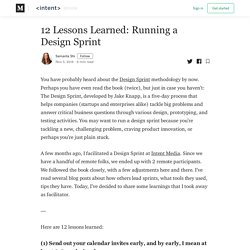

Butterfly Works method toolkit website. Design Won’t Save the World - Jesse Weaver - Medium. Embrace Criticism To Take Design Thinking To The Next Level. It sometimes seems an equal amount of people are mindlessly jumping on the Design Thinking bandwagon as there are people writing obituaries on Design Thinking.

Design Thinking is either The Holy Grail or The Latest Fad. A couple of years ago Harvard Business Review (HBR) put Design Thinking on the cover. Now it publishes a harsh beheading of Design Thinking. Both are helpful in the spread of Design Thinking. Evangelizing helps Design Thinking as much as bashing. Let me explain what I mean… When HBR puts Design Thinking on the cover, it helps to put it in the minds of executives. When the first experiments with Design Thinking are done, questions start to arise. How people see Design Thinking,what the current mental models are,and what the questions people ask themselves are.
This is where the bashing articles come in. No, Design Thinking is not about data In her article Natasha writes: “that the case for its use relies more on anecdotes than data;” Design Thinking Is Fundamentally Conservative and Preserves the Status Quo. Executive Summary Design thinking is, at its core, a strategy to preserve and defend the status-quo – and an old strategy at that. Design thinking privileges the designer above the people she serves, and in doing so limits participation in the design process. In doing so, it limits the scope for truly innovative ideas, and makes it hard to solve challenges that are characterized by a high degree of uncertainty – like climate change — where doing things the way we always have done them is a sure recipe for disaster. The alternative is a design process where the designer is dethroned and where design is less a step-by-step march through a set of stages and more of a space where people can come together and interpret the ways that changing conditions challenge the meanings, patterns, and relationships that they had long taken for granted.
Design Thinking: an enabler for social innovation? - UX Collective. Introduction We live in a world which is becoming more and more complex everyday.

While globalization made challenges more intertwined with the systems that connect us all, internet and information overload led companies and organizations in an unprecedented battle for attention. At the same time, new technologies are creating new opportunities that are causing massive disruptions in society, affecting the way we live, the way we work and do business.
Using H. Ritell’s terminology, we are facing a new wave of “wicked” problems — “class of social system problems which are ill-formulated” (Rittel, 1973) — so new solutions and new methods are needed, as the ones previously used to solve many of the problems we face are no longer effective. The creative problem solving approach of Design Thinking attracts more and more companies who see in it the means to help them break out of the old moulds they have become stuck in, to create alternative ways of looking at a problem. 1.1. 1.2. 12 Lessons Learned: Running a Design Sprint - Intent Design - Medium. You have probably heard about the Design Sprint methodology by now.

Perhaps you have even read the book (twice), but just in case you haven’t: The Design Sprint, developed by Jake Knapp, is a five-day process that helps companies (startups and enterprises alike) tackle big problems and answer critical business questions through various design, prototyping, and testing activities. You may want to run a design sprint because you’re tackling a new, challenging problem, craving product innovation, or perhaps you’re just plain stuck. A few months ago, I facilitated a Design Sprint at Intent Media. Since we have a handful of remote folks, we ended up with 2 remote participants.
We followed the book closely, with a few adjustments here and there. Here are 12 lessons learned: (1) Send out your calendar invites early, and by early, I mean at least 6–8 weeks in advance. (2) Get participants to fully commit to the sprint and make sure that they understand what a sprint is and why you’re doing it.